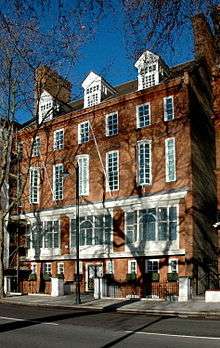Swan House, Chelsea Embankment



Swan House is a Grade II* listed house at 17 Chelsea Embankment on the north bank of the River Thames in Chelsea, central London, England.[1][2][3] Built in 1876 by the architect Richard Norman Shaw, architecturally it is relevant both to the Queen Anne Revival and to the Arts and Crafts movement. It was built by Shaw for the artistic patrons Wickham and Elizabeth Flower.[4] Jones and Woodward, in their Guide to the Architecture of London, consider Swan House to be the "finest Queen Anne Revival domestic building in London."[5]
History
The building is one of eighteen elegant contiguous red-brick houses built in the late 1870s, adjacent to the Chelsea Physic Garden by notable architects of the day.[2] In 1892, the journal The British Architect hailed Swan House and its neighbors as “some of the finest specimens of modern domestic architecture in London.”[6] The building owes its name to its location on the site of what was an inn named The Swan.[7] Creating some confusion, now it is the newer, current structure, rather than the long-destroyed inn that is frequently called the Old Swan House. The old Swan Inn is sometimes misidentified[8] with any of several Swan inns and taverns visited by diarist and politician Samuel Pepys.[9]
The house built in 1875-76 made a home for solicitor and art collector Wickham Flower and his artist wife Elizabeth.[10][11] Norman Shaw, known for the Piccadilly Hotel in Piccadilly Circus, Cragside in Northumberland and Lowther Lodge in Kensington, now headquarters of the Royal Geographical Society, served as the architect.[2][12] Shaw designed the lower part of the building in the Queen Anne Revival style popular during the Victorian Era.[3] He incorporated bay windows on the second floor and dormer windows at the top floor for an unusual look.[12] On the third floor, Shaw alternated flat narrow windows with caged oriel windows.[3] In 1892, The British Architect hailed Swan House and the six other homes Shaw designed in the Chelsea Embankment as “masterpieces.”[6]
Wickham Flower hired the firm of designer William Morris to decorate Swan House.[1] Flower also bought two pieces from his good friend, American expatriate artist James Whistler — Sweet Shop - Note in Orange and Sun Cloud — to display in his home.[1][13]
The four-story building with basement and dormers was listed as a Grade II building on 24 June 1954.[14] Beginning in 1985, Swan House was an architectural studio and office space for many years.[15][16]
After undergoing a 10-year renovation, Swan House was put on sale as a private home in 2007 for £32 million.[11] The home has a 44-by-18-foot ballroom, a cinema and a basement pool.[11] The house was formerly the headquarters of Securicor, and in 1981 presents for the royal wedding of Charles and Diana were stored there. The 19,000-square-foot home also has a dining room seating twenty, private terraces, an elevator, and parking for five cars.[11]
References
- 1 2 3 Historic England. "SWAN HOUSE, 17, CHELSEA EMBANKMENT SW3 (1294208)". National Heritage List for England. Retrieved 3 April 2015.
- 1 2 3 "Chelsea Walk - Chelsea Embankment 13-18". Virtual Museum – The History of the Royal Borough of Kensington and Chelsea. 2006. Retrieved 19 November 2013.
- 1 2 3 Landow, George P. (2011). "Swan House". The Victorian Web. Retrieved 19 November 2013.
- ↑ Lonsdale, Sarah. "Led into temptation". The Daily Telegraph. Telegraph Media Group. Retrieved 2 December 2013.
- ↑ Jones & Woodward. A guide to the architecture of London (Revised and updated ed.). p. 364. ISBN 978-1780224930.
- 1 2 Hogg, A. McGarel; W. Hargreaves Raffles (2 December 1892). "Rambles in London Streets-VI". 38: 403.
- ↑ Hogg, A. McGarel; W. Hargreaves Raffles (2 December 1892). "Rambles in London Streets-VI". 38: 404.
- ↑ As by Reginald Blunt, 1900. An Illustrated Historical Handbook to the Parish of Chelsea (Lamley & Co., London) "Swan Walk" p. 119
- ↑ Pepys, Diary s.v. 10 January and 27 June 1660: the Swan in Dowgate ward, "a poor house, and ill dressed, but very good fish"; 9 June and 25 November 1661, 19 May 1665 and 2 October 1666: the Swan Tavern, "in the Palace-Yard", off King Street Westminster"; 2 August 1662: another Swan Tavern, at Gravesend.
- ↑ "Chapter 5: Park Town and district" (PDF). Survey of London. English Heritage. 2013. p. 21.
- 1 2 3 4 Lonsdale, Sarah (10 February 2007). "Led into temptation". The Telegraph (U.K.). Retrieved 19 November 2013.
- 1 2 "A. D. White Architectural Photographs". Cornell University. Retrieved 19 November 2013.
- ↑ Dowdeswell & Dowdeswell, art dealers (July 1885/1886). "List of pictures sold". Centre for Whistler Studies, Glasgow University. Retrieved 19 November 2013. Check date values in:
|date=(help) - ↑ "Swan House, Kensington and Chelsea". British Listed Buildings. Retrieved 19 November 2013.
- ↑ Cherry, Bridget; Nikolaus Pevsner (1991). London 3: North West (Pevsner Architectural Guides ed.). Yale University Press. p. 573. ISBN 0300096526.
- ↑ "Swan House". Michael Aukett Architects. Retrieved 19 November 2013.
External links
| Wikimedia Commons has media related to Swan House (Chelsea). |
- A view of Swan House from the Thames
- A photograph of the hall at Swan House in 1884 by photographer Henry Bedford Lemere
- A photograph of the staircase at Swan House in 1884 by photographer Henry Bedford Lemere
- A photograph of the drawing room at Swan House in 1884 by photographer Henry Bedford Lemere
- A photograph of one of Swan House's original carpets, designed by William Morris
Coordinates: 51°29′02″N 0°09′48″W / 51.48398°N 0.16343°W